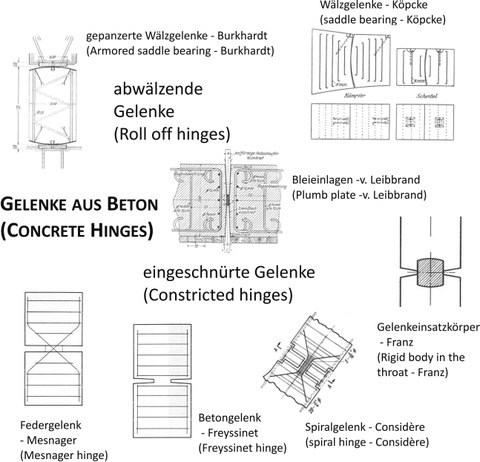Concrete hinges in bridge building
Table of contents
Project data
| Titel | Title
Betongelenke im Brückenbau | Concrete hinges in bridge building |
Report in the yearbook 2009
Concrete Hinges in Bridge Building

Classification of the different types of concrete hinges
Concrete hinges are characterized by an enormous load-bearing capacity and deformability. They are nearly maintenance-free and have a high durability if designed and constructed properly. Concrete hinges are perfectly suited to control the flow of forces and to efficiently reduce constraints.
Since Claus Köpcke first used concrete saddle bearings for an arched bridge near Dresden in 1880, several different types of hinges have been developed, especially in France. While Augustin Mesnager used steel bars to transmit the hinge forces in his “semi-articulation”, Eugène Freyssinet discovered that reinforcement in the throat is unnecessary and axial forces can be transmitted solely by the multi-axial state of compressive stress of concrete and the adequate confinement of adjacent member areas. The figure shows the classification of various types of concrete hinges. All hinges work on the same principle—concentrating compressive stresses in a very small zone (i.e., the throat of the hinge).
Concrete hinges have also been used in Germany, the U.S. and, in particular Switzerland. In the 1960’s, the works of Fritz Leonhardt (Germany), E. O. Fessler (Switzerland), and G. D. Base (Great-Britain), which define the international state-of-the-art until today, led to a renaissance of concrete hinges.
In this project an intensive literature research has been carried out describing the historical development of several types of concrete hinges. Additionally, various existing international design-models for unreinforced concrete hinges were analyzed and compared. The design rules given by Fritz Leonhardt, which are the basis for the design of concrete hinges in Germany, are rooted in the out-dated global safety factor concept, and, therefore, these rules were assigned to the current code to allow an appropriate design of unreinforced Freyssinet hinges.
The first bridge using unreinforced concrete hinges was built in 1909 by Eugène Freyssinet and since then many more bridges have followed. To demonstrate the functional effectiveness of unreinforced concrete hinges, information pertaining to numerous bridges has been researched and gathered. The figure shows the first bridge of Freyssinet with concrete hinges, the Pont du Veurdre over the Allier River in France.
